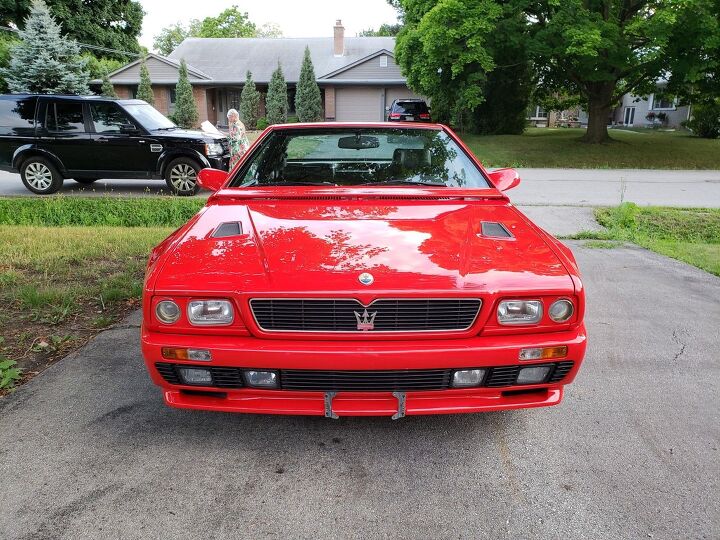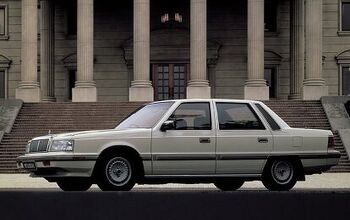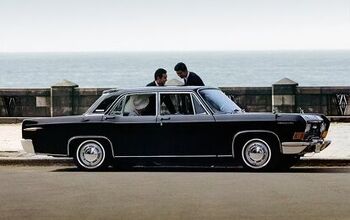Rare Rides: A 1991 Maserati Shamal - Sporty, and Very Square

In the 1990s, nobody in North America spent much (any?) time thinking about Maserati products. So you’d be forgiven if today’s Rare Ride slipped from your fond early-90s memories long ago.
It’s the Shamal, and it’s a bit homely.
Named, like many of Maserati’s other models (not the Biturbo), after a gust of air, Shamal is a wind that blows across large areas of Mesopotamia. As the 1990s fast approached, Maserati sought to blow some hot air into its lineup with a new 2+2 grand touring coupe. The company had not offered a coupe in that particular space since the demise of the Khamsin back in 1982.
Maserati telephoned the Khamsin’s designer, one Marcello Gandini of Lamborghini Countach and Lancia Stratos fame. “One more!” they said. Gandini set to work, and the Shamal debuted in December of 1989 in Modena, Italy. As the flagship coupe of Maserati’s product line, the Shamal shared many parts with the related Biturbo. The body shell, doors, and interior were all carried over in the effort. New were the front and rear end designs, as well as the unique Targa-style decorative bar on the pillars and roof.
All Shamals were powered by a 3.2-liter twin-turbo V8, producing a respectable 321 horsepower and 320 lb-ft of torque. Power was delivered to the rear wheels via the six-speed manual. Not resting on their tech laurels, all Shamals were equipped with an adaptive suspension Maserati developed in conjunction with Koni.
The Shamal was the last model presented by Maserati’s then-owner Alejandro De Tomaso. By the time the new model went on sale in 1990, the company was already nestled under Fiat’s huge corporate umbrella. Shamal remained in production throughout 1996. At the end of its run, just 369 were produced.
For most of the time the Shamal was in production, the visually similar, but softer and more luxurious Ghibli was on offer. Ghibli used smaller engines, was available with an automatic transmission, and was priced below the Shamal. Ghibli remained in production from 1992 through 1998. While neither of those vehicles made it to the North American market, a buyer has retrieved today’s Shamal example from Switzerland and brought it to “Etobicoke,” located in Ontario.
With low miles, the Shamal asks $85,000.
[Images: seller]

Interested in lots of cars and their various historical contexts. Started writing articles for TTAC in late 2016, when my first posts were QOTDs. From there I started a few new series like Rare Rides, Buy/Drive/Burn, Abandoned History, and most recently Rare Rides Icons. Operating from a home base in Cincinnati, Ohio, a relative auto journalist dead zone. Many of my articles are prompted by something I'll see on social media that sparks my interest and causes me to research. Finding articles and information from the early days of the internet and beyond that covers the little details lost to time: trim packages, color and wheel choices, interior fabrics. Beyond those, I'm fascinated by automotive industry experiments, both failures and successes. Lately I've taken an interest in AI, and generating "what if" type images for car models long dead. Reincarnating a modern Toyota Paseo, Lincoln Mark IX, or Isuzu Trooper through a text prompt is fun. Fun to post them on Twitter too, and watch people overreact. To that end, the social media I use most is Twitter, @CoreyLewis86. I also contribute pieces for Forbes Wheels and Forbes Home.
More by Corey Lewis
Latest Car Reviews
Read moreLatest Product Reviews
Read moreRecent Comments
- 3-On-The-Tree Old news if it is even true. But from m my time as Firefighter/EMT fighting vehicle fires when it catches fire it is very toxic.
- Akear Chinese cars simply do not have the quality of their Japanese and Korean counterparts. Remember, there are also tariffs on Chinese cars.
- 3-On-The-Tree My experience with turbos is that they don’t give good mpg.
- GregLocock They will unless you don't let them. Every car manufacturing country around the world protects their local manufacturers by a mixture of legal and quasi legal measures. The exception was Australia which used to be able to design and manufacture every component in a car (slight exaggeration) and did so for many years protected by local design rules and enormous tariffs. In a fit of ideological purity the tariffs were removed and the industry went down the plughole, as predicted. This was followed by the precision machine shops who made the tooling, and then the aircraft maintenance business went because the machine shops were closed. Also of course many of the other suppliers closed.The Chinese have the following advantagesSlave laborCheap electricityZero respect for IPLong term planning
- MaintenanceCosts Yes, and our response is making it worse.In the rest of the world, all legacy brands are soon going to be what Volvo is today: a friendly Western name on products built more cheaply in China or in companies that are competing with China from the bottom on the cost side (Vietnam, India, etc.) This is already more or less the case in the Chinese market, will soon be the case in other Asian markets, and is eventually coming to the EU market.We are going to try to resist in the US market with politicians' crack - that is, tariffs. Economists don't really disagree on tariffs anymore. Their effect is to depress overall economic activity while sharply raising consumer prices in the tariff-imposing jurisdiction.The effect will be that we will mostly drive U.S.-built cars, but they will be inferior to those built in the rest of the world and will cost 3x-4x as much. Are you ready for your BMW X5 to be three versions old and cost $200k? Because on the current path that is what's coming. It may be overpriced crap that can't be sold in any other world market, but, hey, it was built in South Carolina.The right way to resist would be to try to form our own alliances with the low-cost producers, in which we open our markets to them while requiring adherence to basic labor and environmental standards. But Uncle Joe isn't quite ready to sign that kind of trade agreement, while the orange guy just wants to tell those countries to GFY and hitch up with China if they want a friend.








































Comments
Join the conversation
I like it. Not worth anywhere close to $85K -- but it's a crazy little car with some grunt. Only thing I'd do is remove those body colored headlight bezels and paint them black. Very nice wheels on this car, too. The factory ones are fairly pedestrian. Reliability would be a huge concern, though. I remember test driving an early BiTurbo -- and that hunk of crap overheated about 5 minutes in. Electric fans failed to turn on. Couldn't believe it when the salesman popped the hood and took the radiator cap off. That brilliant move resulted in a Yellowstone-like coolant eruption.
Probably the last attractive Maserati vehicle.